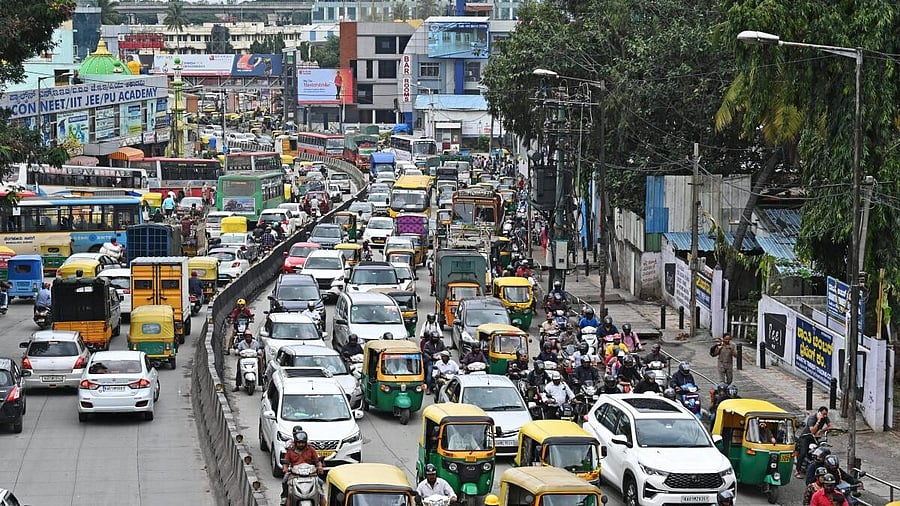
Representative image of cars in Bengaluru.
Credit: DH PHOTO/PUSHKAR V
Bengaluru has for long been plagued by severe traffic congestion. With a booming population and rapid urban expansion, the city’s transportation system has become a major bottleneck. In response, the Directorate of Urban Land Transport (DULT) developed a Comprehensive Mobility Plan (CMP) in 2020, which aimed to create a sustainable, equitable and efficient transportation ecosystem. The CMP envisaged a coordinated effort to improve mobility through a multi-modal transport system, reducing congestion and pollution. However, despite these ambitious goals, the government’s actions have failed to align with this vision, continuing to reinforce a car-centric model that has already proven ineffective. A recent proposal by Altinok Consulting Engineering Inc, commissioned by the Bruhat Bengaluru Mahanagara Palike (BBMP), highlights this troubling disconnect. The feasibility report suggests constructing multiple elevated corridors, flyovers and tunnel roads. While these projects might temporarily alleviate traffic in some areas, they primarily promote private vehicle use, exacerbating the cycle of congestion. New roads will only attract more cars, worsening pollution, and diminishing the quality of life for residents. Experts have criticised these plans for overlooking pedestrians and cyclists, focussing solely on facilitating vehicle movement.
Instead of expanding roads, Bengaluru should focus on a “public-transport-first” approach. The city’s priorities should include augmenting the metro network, speeding up work on circular rail, increasing the frequency of BMTC buses and enhancing first and last-mile connectivity. A seamless and efficient multi-modal transportation will encourage people to adopt public transport, making it a default choice and minimising their reliance on personal vehicles. Bengaluru should draw inspiration from global best practices. In cities like Luxembourg, public transport is free, while many municipalities have implemented strategies like increased parking fees or entry cess to central business district during peak hours to discourage unnecessary vehicle use. These measures not only reduce congestion, but also promote sustainable mobility.
The central problem with Bengaluru’s current approach lies in its continued emphasis on personal vehicles, rather than people-centric infrastructure. The city’s mobility plans need a significant rethink. Instead of investing in projects that increase the vehicle footprint, the government should implement the vision outlined in the CMP— prioritising public transport, walking and cycling, and reducing dependence on private vehicles. Bengaluru’s future hinges on adopting better, greener transportation options that cater to all its residents, regardless of income or social status. Only by giving preference to people over vehicles, can the city tackle its traffic gridlocks, improve air quality, and create a more liveable urban environment. It is time to shift focus towards building infrastructure that moves people, not just cars.
